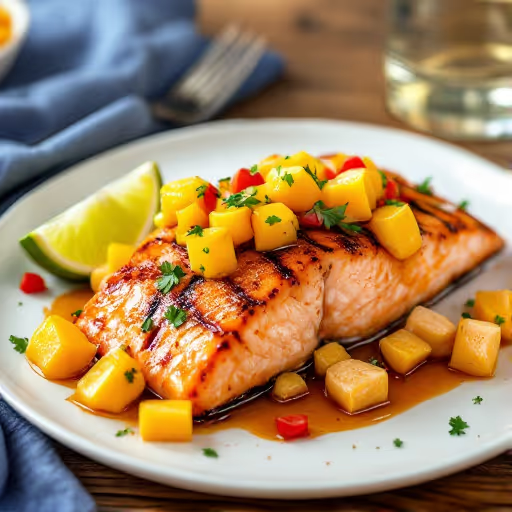Grillwisehub FAQ for:
Grilled BBQ Salmon with Mango Salsa
What are some foods I can pair with Grilled BBQ Salmon with Mango Salsa?
This versatile BBQ salmon pairs beautifully with several complementary side dishes. For a complete meal, consider serving it with fluffy coconut rice (200g/260 calories) or lime-infused quinoa (150g/180 calories), which both complement the tropical mango salsa perfectly. For lighter options, try grilled asparagus spears (100g/20 calories) or a cucumber and avocado salad (120g/105 calories). Roasted sweet potatoes (150g/135 calories) offer a lovely contrast to the smoky salmon with their natural sweetness. For maximum nutritional benefit, pair with a leafy green side salad featuring spinach, rocket, and colourful vegetables dressed with a light citrus vinaigrette. If you're following the low-calorie version, cauliflower rice (150g/30 calories) makes an excellent base. For entertaining, serve with a side of grilled corn on the cob (one medium ear/90 calories) brushed with lime juice and a sprinkle of smoked paprika to echo the flavours in the salmon marinade. All these pairings work well with both the traditional and low-calorie versions while maintaining the recipe's fitness-focused profile.
What's the best way to prevent my salmon from sticking to the grill?
To prevent salmon from sticking to your BBQ grill, follow these essential steps: First, ensure your grill grates are thoroughly cleaned before cooking. For the traditional recipe, oil the grates well as directed, but for even better results, leave the skin on the salmon (it creates a natural barrier). Place the salmon skin-side down on the indirect heat zone at 180°C (350°F) and resist the urge to flip or move it too early. The salmon will naturally release from the grates when it's ready. Alternatively, you can use a fish grilling basket or place the salmon on a piece of aluminium foil with small holes punched in it for smoke penetration. This technique works for both the traditional and low-calorie versions, though the skinless low-calorie fillets require extra care with a good coating of cooking spray on the grates.
How can I tell when my salmon is perfectly cooked without overcooking it?
Perfectly cooked salmon should be moist and tender, not dry or rubbery. The most reliable method is using an instant-read thermometer inserted into the thickest part of the fillet—aim for 63°C (145°F) for food safety whilst maintaining tenderness. Without a thermometer, look for these visual cues: the salmon will change from translucent to opaque pink, and when gently pressed with a fork, it should flake easily but still maintain some translucency in the very centre (this will continue cooking during the 5-minute rest period). A common mistake is overcooking salmon due to fear of undercooking—remember that salmon continues cooking after removal from heat. For fillets of different thicknesses, start checking thinner portions earlier, around 10 minutes, while thicker cuts may need the full 15 minutes. The cooking time remains consistent for both the traditional and low-calorie versions, but the skinless low-calorie fillets may cook slightly faster, so begin checking at 10 minutes.
How does the nutritional profile of this recipe support a fitness-focused diet?
This BBQ salmon recipe is exceptionally well-suited for fitness enthusiasts. The traditional version provides excellent macronutrient distribution (approx. 38% protein, 49% fat, 13% carbs) with 255 calories per serving, while the low-calorie version offers an impressive 60% protein, 31% fat, and 9% carbs at just 175 calories. Both versions deliver high-quality protein (24-26g per serving) crucial for muscle repair and growth. The salmon itself is rich in omega-3 fatty acids (particularly EPA and DHA), which have been scientifically proven to reduce inflammation and support recovery after intense exercise. The low-calorie version, with its reduced fat content (6g vs 14g) and slightly higher protein, is ideal for cutting phases or those prioritising lean protein intake. The mango in the salsa provides natural carbohydrates for energy and contains bromelain enzymes that may help reduce exercise-induced inflammation. For maximum fitness benefits, pair with complex carbohydrates like brown rice (100g cooked/110 calories) or sweet potato (100g/90 calories) to create a balanced post-workout meal with optimal protein-to-carbohydrate ratio.
What's the best way to store and reheat leftover grilled salmon?
For proper storage of leftover grilled salmon, cool it quickly (within 2 hours of cooking) and refrigerate in an airtight container for up to 3 days. The mango salsa should be stored separately and can keep for 1-2 days. Never bring cold salmon to room temperature before reheating, as this creates a food safety risk. For best results when reheating, use one of these methods: 1) Gentle oven warming - place salmon on a baking sheet, cover with foil, and heat at 150°C (300°F) for 10-15 minutes until it reaches 63°C (145°F) internally; 2) Steaming - place in a steamer basket over simmering water for 5-7 minutes; 3) Microwave with caution - cover with a damp paper towel and heat in 30-second intervals at 50% power until warmed through. If you have vacuum sealing equipment, seal and refrigerate portions immediately after cooling for optimal freshness. For longer storage, you can freeze properly wrapped salmon for up to 2 months, but the texture may change slightly. The salsa doesn't freeze well and is best made fresh. Always ensure reheated leftovers reach the safe temperature of 63°C (145°F).






